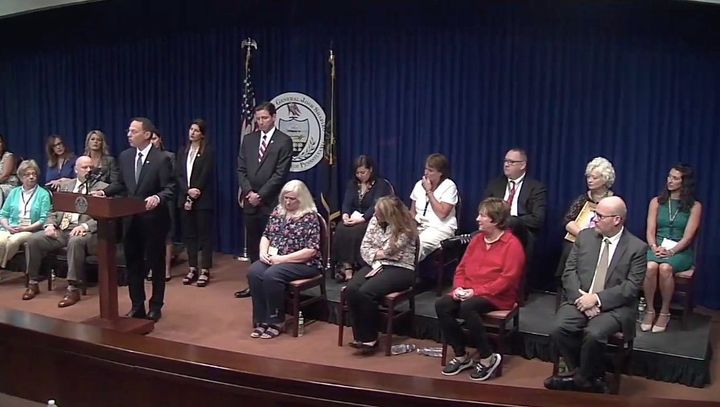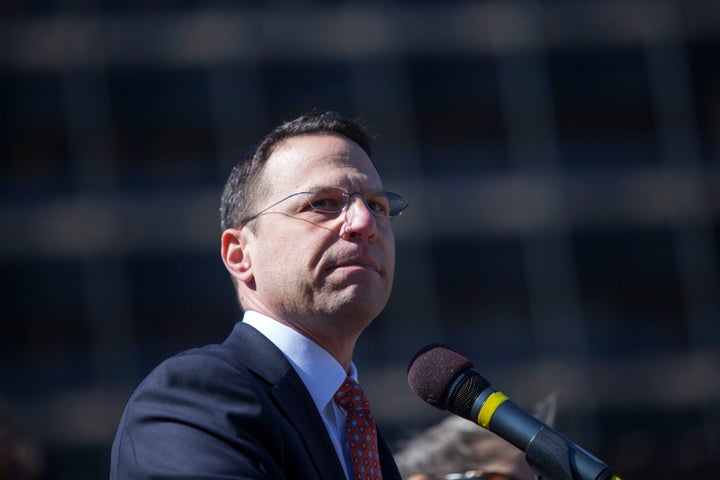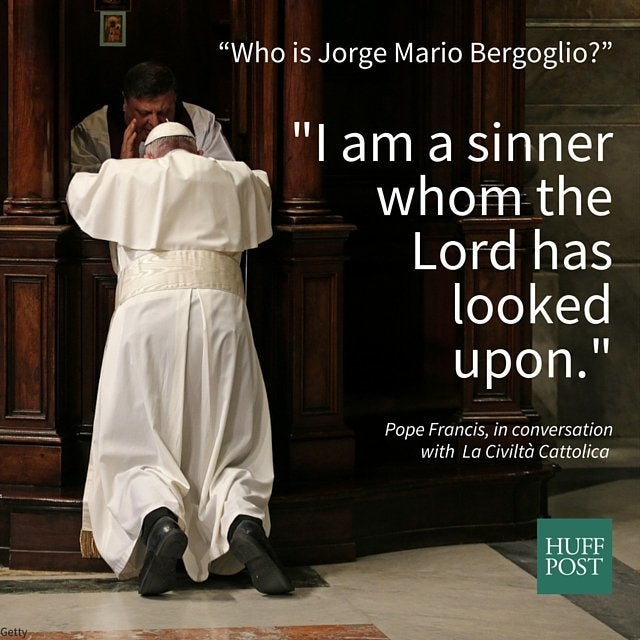
Pennsylvania’s attorney general released on Tuesday the long-awaited results of a damning grand jury investigation into how six Roman Catholic dioceses in the state covered up sexual abuse by 301 “predator priests” over 70 years.
The 884-page report is the largest, most comprehensive investigation on the church’s sex abuse scandal by a U.S. state, according to Attorney General Josh Shapiro. The grand jury identified over 1,000 victims in the six dioceses examined in the report: Allentown, Erie, Greensburg, Harrisburg, Pittsburgh and Scranton. But the jurors suspected the real number of victims could be much higher.
Shapiro said the report, which was delayed for months while individuals named in it raised legal challenges over what portions should be redacted, showed that senior church leaders in these dioceses and even at the Vatican knew abuse was occurring but systematically covered it up.
“The pattern was abuse, deny and cover up,” Shapiro said during a news conference Tuesday.
Listen to Attorney General Josh Shapiro’s news conference with victims below.
Most of the victims identified in the report were boys, but some were girls. The abuse documented included groping, being made to masturbate with assailants, and being raped orally, vaginally or anally.
The jurors accused Catholic Church leaders in the state of working hard to avoid public scandal and protect abusers. The grand jury found that victims were “brushed aside, in every part of the state, by church leaders who preferred to protect the abusers and their institutions above all.”
“Church officials routinely and purposefully described the abuse as horseplay and wrestling and inappropriate conduct. It was none of those things. It was child sexual abuse, including rape,” Shapiro said.
Matt Haverstick, an attorney representing the dioceses of Harrisburg and Greensburg, insisted in a statement that the Catholic Church discussed in the grand jury report no longer exists.
“The Dioceses I’ve gotten to know so well over the past two years are incredibly sorry for the harm to these survivors,” Haverstick said. “Today’s Church has listened and learned from its mistakes, and its reforms over the past two decades keep children safe.”
At the end of their report, jurors included hundreds of pages of previously hidden church documents that illustrate how officials handled reports of abuse. The release also included response statements from the six dioceses. Some of the individuals named in the report included their own rebuttals of the claims made by the grand jury.
In one egregious case in the Diocese of Scranton, a priest impregnated a young girl and then arranged an abortion, the report reads. The priest resigned in 1986 and was sent to a Catholic psychiatric treatment center. One year later, in 1987, he was reassigned to another Pennsylvania parish. In 1989, the victim received a settlement from the diocese and, in exchange, was asked to sign a confidentiality agreement. Meanwhile, the priest continued in active ministry until 2002.
In the Diocese of Allentown, the report claims a priest who freely admitted to sexually molesting a boy was allowed to continue in ministry for several years after his confession. The diocese concluded at the time that “the experience will not necessarily be a horrendous trauma” for the victim.
In the Diocese of Pittsburgh, church officials dismissed a report that a priest had abused a 15-year-old girl, claiming the girl had “literally seduced” him into a relationship.
Tim Lennon, president of the Survivors Network of those Abused By Priests, told HuffPost he was saddened and angered by the report. He believes it proves the church hierarchy was complicit in the abuse. They knew abuse was happening and didn’t work hard enough to discipline abusers, he said, which in turn enabled more abuse to happen over the years.
“They knew for years if not decades of this vile corruption. Those in the church hierarchy went to great lengths to hide and dismiss the suffering of survivors,” Lennon told HuffPost. “How many children were raped and sexually abused because the church authorities covered up sexual abuse and did nothing?”
During the investigation, which began in July 2016, the grand jury heard from dozens of witnesses and reviewed over 500,000 pages of documents from diocesan archives. The probe led to the arrests of two priests on child sexual abuse charges.
However, most of the priests identified in the report may never be brought to justice. Shapiro said most of the accused either are dead or the alleged crimes are too old to prosecute.
The grand jury report faced heated, behind-the-scenes challenges on its road to publication. A group of individuals named but not indicted in it argued that their right to due process would be violated if they couldn’t hold hearings to challenge parts of the grand jury report and try to protect their reputations. In June, the state’s Supreme Court decided to block the report’s publication.
Shapiro fought the decision ― at one point appealing to Pope Francis to step in and persuade the individuals to drop their efforts to block the report. Seven news organizations also petitioned the state Supreme Court to try to force the report’s release ― including the Associated Press, Telemundo Mid-Atlantic, NBC subsidiaries, and several Pennsylvania-based publications.
In the end, the report was published with the names of some Catholic clergy redacted. The state Supreme Court plans to consider oral arguments on those individuals’ claims in September, the AP reports.

Previous investigations have uncovered widespread clergy sexual abuse in the state’s other two dioceses, Philadelphia and Altoona-Johnstown.
Smaller states, including Maine and New Hampshire, have issued reports on the extent of the Roman Catholic Church’s sex abuse scandal. But Pennsylvania is the largest state to date that has conducted such an investigation.
In April, the Erie diocese tried to get ahead of the report by releasing the names of 51 former priests and lay leaders who were credibly accused of sexual misconduct, ranging from providing pornography to minors to sexual assault.
Erie’s Bishop Lawrence Persico said in a statement that it was “shocking to read the graphic details” in the grand jury report. In a letter that was read aloud in all 97 parishes of the 13-county diocese on Sunday, the bishop said it was clear that church leaders failed to adequately address the problem.
“The most important thing I want to do at this moment is to express my sorrow to the victims of sexual abuse that occurred within the Diocese of Erie,” Persico wrote in the letter. “As the grand jury report demonstrates, they have experienced cruel behavior by the very individuals who should have had the greatest interest in protecting them.”

The Harrisburg diocese followed Erie’s example in August, when it released a list of 71 priests and other members of the church who had been accused of sex abuse. The diocese also removed the names of accused bishops from its church buildings.
On Friday, Pittsburgh Bishop David Zubik said a few priests named in the report were still in ministry. He said diocesan investigations had concluded that those allegations were unsubstantiated.
Currently, Pennsylvania law states that adults in their 30s and older who were abused as children can’t sue for damages. Criminal charges can’t be filed after the alleged victim turns 50.
The grand jury had four recommendations moving forward ― removing the criminal statute of limitations, establishing a temporary window for victims older than 30 to sue the dioceses, tightening laws about mandatory reporting, and making sure confidentiality agreements don’t give either party the right to decline to cooperate with criminal investigations.
The church has opposed moves to change the statute of limitations, claiming it would be financially crippling to Pennsylvania’s Catholic schools and parishes. Fifteen U.S. Catholic dioceses or archdioceses have filed for bankruptcy protection because of the clergy sexual abuse crisis, according to the watchdog group BishopAccountability.org.
Lennon applauded Shapiro’s courage in empaneling a grand jury. But he said the work of exposing sexual abuse within the Catholic Church is far from over.
“We see that when civil society investigates we get the truth,” Lennon said. “There must be a grand jury in every state.”
This story has been updated with more details from the report.

